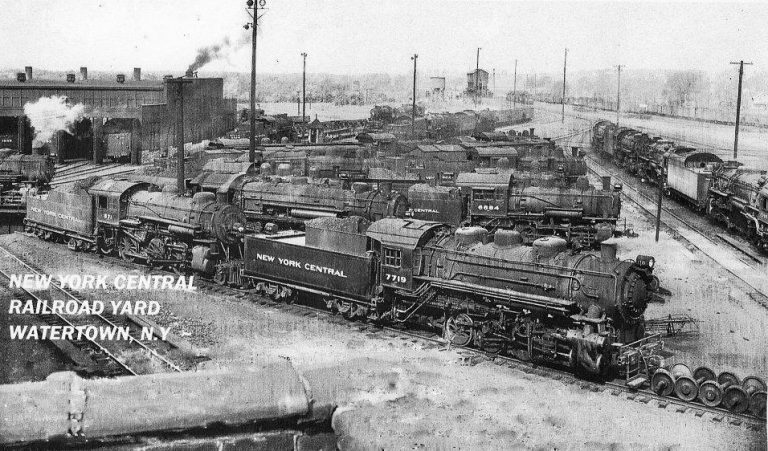New York Central Coal Trestle In The Pine Street Rail Road Yard, Built In 1919
The New York Central coal trestle in the Pine Street railroad yard was built in conjunction with the engine terminal and roundhouse constructed in 1918-1919. Situated west of the roundhouse, the coal trestle ran perpendicular to a couple of Sand Flats streets, Casey and Dorsey while the roundhouse itself was located at the end of Smith (Coleman) Ave.

The project was a hastily executed decree by the Federal Government’s wartime spending effort to improve railroad services and capacities as part of a $1,000,000,000 effort. Locally, the New York Air Brake (NYAB) ramped up production as part of the effort, the NYAB employing seven thousand people at one point – many of whom were making munitions, cannons, and large caliber guns.
The amount of manufacturing necessitated the many improvements and additions the New York Central would undergo and also contributed to the area’s growth. With a housing crisis on its hands, Watertown was able to create public housing via the United States Housing Corps and constructed over 200 Government-funded homes on the City’s north side close proximately to the NYAB. The community, known as Lansingdorp and named after then Secretary of State and Watertown Native Robert Lansing, would become home to many of the new migrants to the city looking for work.

Unlike the NYAB, the New York Central was facing a labor crisis and delays in getting the project completed as a result, to some extent, of the war itself. As the Watertown Daily Times reported–
The Officials of the St. Lawrence division of the New York Central are also facing a serious situation so far as labor is concerned and this week, Superintendent J. W. Evans, general Agent W. H. Northrop, Division Freight Agent Frank L. Wilson and Division Engineer P. H. Winchester conferred with the local draft board to ascertain whether or not the railroad was to be protected through exemption of its employees from the draft.

It was estimated it would take a year and a half to complete the roundhouse project, including the coal trestle, a boiler shop, ash pits, and water tanks, as well as the tracks leading to and from the roundhouse. The length of the coal trestle would be 300 feet and contain 24 pockets while the roundhouse layout would also include an annex for the offices, shops, and store room.
At nearly the same time, a cooperated effort between the city and New York Central was underway for the grading and relocating of the Massey Street crossing which was considered amongst the worst hazards in the St. Lawrence Division having suffered a numbered of recent fatalities, including a family of three whose car was struck by a locomotive on the tracks.

In addition to this work, the rail yard itself was to be expanded to become 90-car tracks and four additional 90-car tracks on the east side of the yard. With so much to do in the midst of a world war, it’s no wonder it would take nearly 2 years to complete.
By the time it was torn down in 1952, the “old” engine house had been abandoned, and the switch to diesel engines had occurred in the previous decades.
















1 Reviews on “Pine Street RR Yard Coal Trestle (1919 – 1952)”
The Sanborn map mis-labeled Smith Street as Coleman Avenue. Coleman Ave, formerly Smith Avenue, was further west, beyond Duffy and Casey Streets and was renamed in early 1950s to eliminate confusion between the two streets. The roundhouse was at the end of Smith Street.
Thanks for pointing that out. I remember looking at this map panel and another one and kept thinking something didn’t look right, but did notice they printed “(Smith)” closer to the roundhouse and figured it was one of those unexplained anomalies.